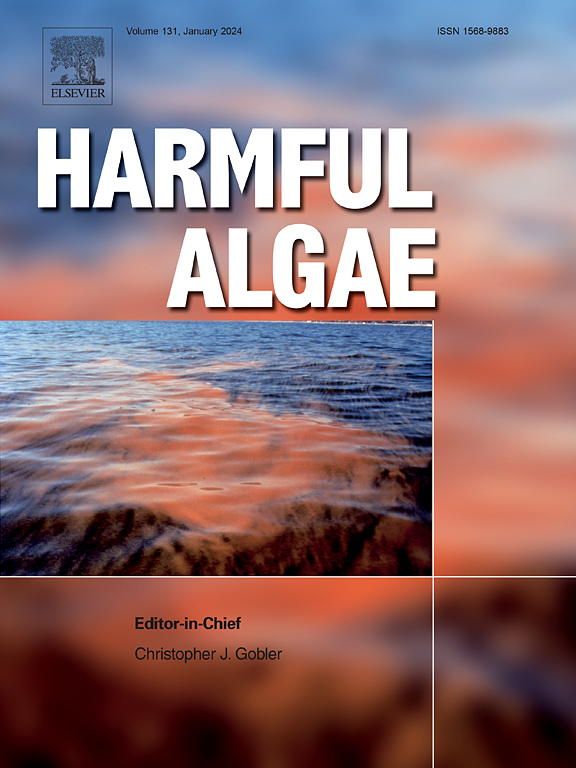利用satdna作为染色体标记评估西班牙西北部亚历山大花的基因组多样性
IF 4.5
1区 生物学
Q1 MARINE & FRESHWATER BIOLOGY
引用次数: 0
摘要
小亚历山大菌是一种有毒的鞭毛藻,已知有许多菌株产生麻痹性贝类毒素(PSTs)。考虑到全球沿海水域黄颡鱼的生态重要性和社会经济影响,本研究通过分析2018年发生在Ría de Vigo(西班牙西北大西洋海岸)的黄颡鱼赤潮事件获得的克隆培养物,评估了基因组多样性。据我们所知,这是卫星dna (satdna)第一次被荧光原位杂交(FISH)用作染色体标记来分析花中的基因组多样性。单态的AmSat002-6和与45S rDNA共定位的AmiSat017-88和AmiSat059-512可以作为研究性取向及其在开花中的潜在作用和其他可能影响黄花生命周期的因素的标记。4个satdna (AmiSat021-510、AmiSat041-75、AmiSat048-3-AAG和AmiSat060-65)具有多态性,并在3周内对从7个位点分离的12株克隆菌株进行了基因分型。此外,还对来自地中海不同来源的3株小芽孢杆菌进行了基因分型。每个菌株都有其独特的四satdna基因型。聚类分析和相似性分析没有发现开花菌株的时空类群;这种分散甚至比地中海菌株之间的分散更大,地中海菌株位于开花菌株之间。沙豆科植物sat-DNA FISH模式的差异可能有助于对属多样化的评价。本文章由计算机程序翻译,如有差异,请以英文原文为准。
Assessing the genomic diversity of a NW Spain bloom of Alexandrium minutum using satDNAs as chromosomal markers
Alexandrium minutum is a toxic dinoflagellate with numerous strains known to produce paralytic shellfish toxins (PSTs). Given the ecological importance and socio-economic impact of A. minutum blooms in coastal waters worldwide, this study assesses the genomic diversity by analysing clonal cultures obtained from an exceptional A. minutum red tide event that occurred in the Ría de Vigo (NW Atlantic coast of Spain) in 2018. To our knowledge this is the first time that satellite DNAs (satDNAs) has been used as chromosomal markers by fluorescence in situ hybridization (FISH) to analyse genomic diversity in a bloom. AmSat002-6, which is monomorphic, and AmiSat017-88 and AmiSat059-512, which colocalized with 45S rDNA can be used as markers to investigate the role of sexuality and its potential role in blooms and other factors that may influence the life cycle of A. minutum. Four satDNAs (AmiSat021-510, AmiSat041-75, AmiSat048-3-AAG and AmiSat060-65) are polymorphic and were used to genotype twelve clonal strains isolated from seven sites over three weeks. In addition, three A. minutum strains from different Mediterranean origins were genotyped. Each strain was distinguished by its unique four-satDNA genotype. Clustering and similarity analyses did not reveal any spatial or temporal grouping of the bloom strains; the dispersion was even greater than the dispersion among the Mediterranean strains, which lay between the bloom strains. The differences in the FISH patterns of sat-DNA within A. minutum may contribute to the assessment of genus diversification.
求助全文
通过发布文献求助,成功后即可免费获取论文全文。
去求助
来源期刊

Harmful Algae
生物-海洋与淡水生物学
CiteScore
12.50
自引率
15.20%
发文量
122
审稿时长
7.5 months
期刊介绍:
This journal provides a forum to promote knowledge of harmful microalgae and macroalgae, including cyanobacteria, as well as monitoring, management and control of these organisms.
 求助内容:
求助内容: 应助结果提醒方式:
应助结果提醒方式:


